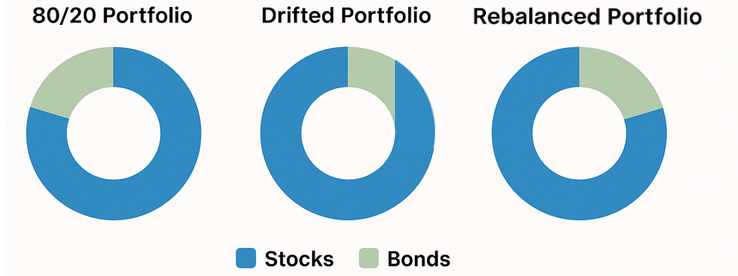- Compounded Capital
- Posts
- What Is Portfolio Rebalancing?
What Is Portfolio Rebalancing?
How rebalancing helps you stay on track — without chasing the market
Let’s say you’ve built a portfolio with a plan:
80% in stocks
20% in bonds
You chose that mix for a reason — maybe because you're aiming for growth with a cushion of stability.
But markets move.

Stocks might go up 10%, while bonds stay flat. Suddenly your portfolio is more like 85/15.
That means you're taking on more risk than you originally planned — without even realising it.
That’s where rebalancing comes in.
Why rebalancing matters
Rebalancing means adjusting your investments to bring them back in line with your original plan.
It’s about keeping your risk level consistent — not chasing returns.
When stocks soar, you sell a bit of them to lock in profits.
When markets dip, you buy more — while prices are low.
You’re doing the opposite of what most people do. And that’s a good thing.
Here’s a simple example:
Imagine you invest £10,000:
£8,000 in global stocks (like VWRL or IWDA)
£2,000 in bonds (like IGLT or AGGH)
A year later, stocks are up and your portfolio’s now worth:
£9,500 in stocks
£2,000 in bonds
Your stock portion is now 83% of your portfolio. You’re taking on more risk than you started with.
So, you rebalance: sell some stock, buy some bonds — and bring it back to 80/20.
It sounds boring. But it’s disciplined. And over decades, it adds up.
When to rebalance
You don’t need to micromanage your portfolio. Most people do this:
✅ Once or twice a year
✅ When an asset class shifts 5–10% from your target allocation
Rebalancing too often creates unnecessary fees and taxes.
But ignoring it completely? That’s a recipe for accidental risk.
Why it works
Rebalancing supports:
Risk control – You stay aligned with your goals
Buy low, sell high – You naturally take profits and top up undervalued assets
Discipline – You avoid reacting emotionally to market swings
It’s a system, not a guess.
🧰 How to Rebalance Your Portfolio (UK Edition)
Now that you understand why rebalancing is important, let’s look at how to actually do it - especially if you’re investing through UK platforms.
1. Use New Contributions
One of the simplest and most tax-efficient ways to rebalance is by directing new deposits into the underweight asset class. For example, if your portfolio has drifted to 85% stocks and 15% bonds (from a target of 80/20), allocate your next contributions fully into bonds until you're back in balance. This avoids unnecessary selling and transaction fees.
2. Use Dividends
If your investments generate dividends or interest, reinvest those proceeds into whichever asset class is lagging. Over time, this "passive rebalancing" helps maintain your allocation without triggering capital gains.
3. Manual Rebalancing on Platforms
If you need to actively rebalance, here’s how to do it on popular UK platforms:
Vanguard UK: Log in to your account, use the "exchange" function to move money between funds within your ISA or SIPP.
Hargreaves Lansdown / AJ Bell: Sell overweight positions and use the proceeds to buy more of the underweight assets. Rebalancing can be done during your regular portfolio review.
Trading 212 (T212):
If you're using the Invest or ISA account, manually sell a portion of the overweight asset and buy more of the underweight one.
If you use AutoInvest/Pies, T212 allows automatic rebalancing: just set your target percentages and use the "rebalance" button—no need to sell/buy manually.
T212 trades are commission-free, making frequent rebalancing more viable than on fee-based platforms.
Nutmeg / Moneyfarm / Wealthify: These robo-advisors automatically rebalance for you based on your risk profile and asset drift.
4. Watch Out for Fees & Taxes
Inside an ISA or SIPP: All rebalancing actions are tax-free. You won’t pay capital gains or dividend tax.
In a General Investment Account (GIA): Selling assets to rebalance could trigger Capital Gains Tax (CGT) if gains exceed the annual allowance (£3,000 for 2025/26).
Trading 212 users: While T212 offers commission-free trading, rebalancing within a GIA still risks CGT exposure. Consider rebalancing within your ISA to avoid tax complications.
Final thought
You don’t need to be glued to charts.
You don’t need to time anything.
Just check in a couple of times a year.
Adjust if needed. And carry on.
Rebalancing is like brushing your teeth — not exciting, but essential.
It keeps your portfolio clean, consistent, and in line with your plan — not the market’s mood.
Let time and consistency do the work.
You just need to stick to your rhythm.